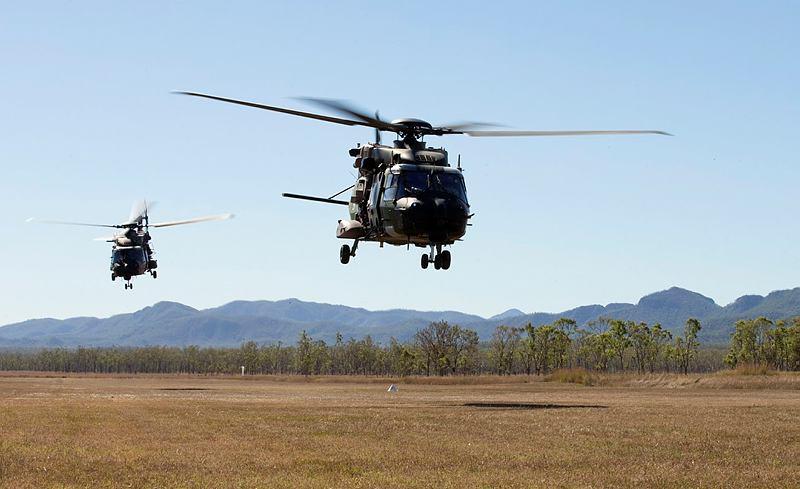The path ahead for Army aviation
Posted By Andrew Davies on June 26, 2015 @ 06:00
 [1]
[1]When I started to ponder Army aviation in its totality, I realised that force structure planning and project definition for Army aviation is a bit of a mess. Lest that sound a bit harsh, let me say that most of the elements work okay in practice, albeit with a question mark over a couple. And some of the more egregious problems weren’t Army’s fault. But it’s hard to see much coherence across the spectrum of capabilities and projects. And given that Army spent the period 1999–2014 pretty much continuously on operation, the fact that it didn’t manage to have its own utility and armed reconnaissance helicopters in theatre in Afghanistan, often relying on coalition air support instead, suggests some issues.
Let’s start with the MRH-90 multi-role helicopter, a contender for the replacement for the S70 Blackhawks when fleet ‘rationalisation’ [2] was the flavour of the month. Fast forward to the present day, and we find the Navy is in the process of taking delivery of 24 new Romeo model Seahawk combat helicopters from the United States, while the Army continues to operate Black Hawks while working to get the MRH90s up to speed. (See here [3] for more.) Not much in the way of rationalisation has been achieved—and Army wants something else for special forces.
Then there’s the Armed Reconnaissance Helicopter, now well over seven years late. When the decision to acquire it was made, the Apache was in service with American and other forces and ready to go. Fortunately, some sterling work from the project team, industry and Army has got the Tiger to where the ADF wants it to be. But it’ll be an orphan in terms of configuration and when it comes time to upgrade the aircraft (according to the most recent public DCP sometime around 2020) we’ll have to decide whether to continue to develop our unique capability or buy something else—either way it’ll be expensive.
And while we were still faffing round with our Tigers, the French had theirs flying combat missions in Afghanistan, Libya and Mali. That suggests that the local problem wasn’t so much the airframe as the systems architecture we were trying to fit it into.
At least Army can’t blame others for missed opportunities on UAVs. Its first attempt at the world of UAVs was essentially a case of overreach of ambition, specifications that couldn’t be met, irreconcilable technical problems and, eventually, project cancellation. (See page 182 of the 2008 ASPI budget brief [4].) In the meantime, Army got its hands on ScanEagle and the man-portable Skylark, and discovered that you can do more with less in this space. When the larger and largely contractor supported Heron was added to the ADF mix, it suddenly looked like a pretty handy suite of UAVs. All that was missing was an armed UAV to provide persistent armed reconnaissance and flying fire support. All the noises around an armed drone capability [5] suggest that we might soon have one.
Army also has to work out what its amphibious capability will look like and will have to master embarked aviation operations. And if there’s one place a rationalised helicopter force with overlapping logistics chains would be useful, it’d be on a ship. To some extent with Navy’s MRH90 utility helicopters alongside Army’s will work, but if we want to add ASW helicopters to the mix there’ll be little commonality.
In summary, Army’s aviation force structure is a mixture of the good, the not-so-good and the ‘time will tell’. And it has come together in an ad hoc way (and at a painfully slow pace). It’s worth thinking about what a strategic plan for Army aviation would look like. I don’t think it’s too hard. The Army—and the ADF more broadly—needs to be able to do a couple of things well.
First, it needs to be joined up—not exactly a startling conclusion when ‘network centric’ and ‘jointery’ have been catch phrases for years. But it hasn’t obviously been factored highly enough in some decisions—ARH certainly wasn’t a ‘plug and play’ force element off the shelf. Intra-ADF connectivity, including tactical data links between all of the combat platforms should be a no-brainer.
Second, Army needs to be able to get to coalition operations and plug into American and NATO compatible networks. And it needs to be able to take its own aviation along, confident that it can work with partners. The easiest way to do that is to source platforms from the same place, with connectivity and compatibility built in. There’s a lot to be said for sourcing materiel from the US as a default position, and buying established and mature platforms through Foreign Military Sales works best of all.
Being able to plug into American systems just makes sense, and makes everyone’s life easier. If we keep our kit at the same baseline as American forces, interoperability follows. And given that the Navy and Air Force are pretty much on the path of interoperability with the US anyway, moving the Army in the same direction would also make ADF intra-operability easier.
This post is adapted from a talk given at ASPI’s Land Forces Conference yesterday. The script for the talk is here [6].
Article printed from The Strategist: https://aspistrategist.ru
URL to article: /the-path-ahead-for-army-aviation/
URLs in this post:
[1] Image: https://aspistrategist.ru/wp-content/uploads/2015/06/20150514adf8518511_057.jpg
[2] fleet ‘rationalisation’: https://www.aspistrategist.ru/publications/rational-to-rationalise-australias-future-naval-combat-helicopters-revisited-by-andrew-davies
[3] here: https://aspistrategist.ru/the-curious-case-of-the-mrh90/
[4] 2008 ASPI budget brief: https://www.aspistrategist.ru/publications/the-cost-of-defence-aspi-defence-budget-brief-2008-2009
[5] an armed drone capability: https://aspistrategist.ru/the-adf-and-armed-drones/
[6] here: https://aspistrategist.ru/wp-content/uploads/2015/06/ASPI-conference-Army-aviation.pdf
Click here to print.